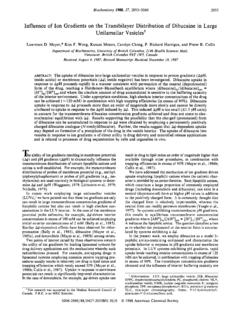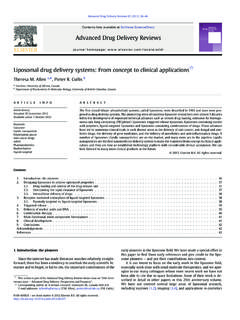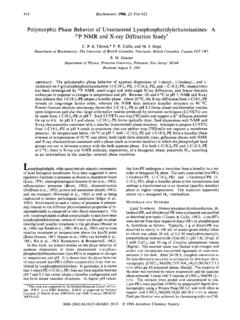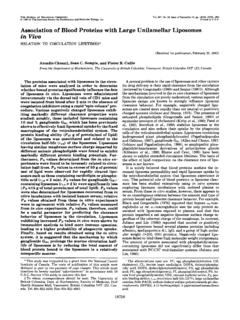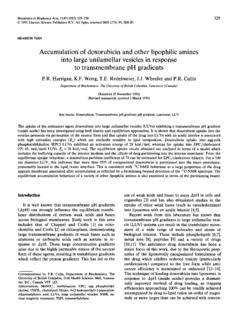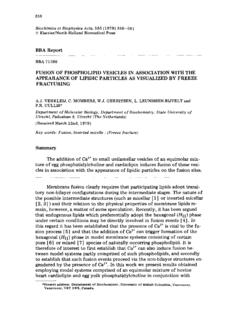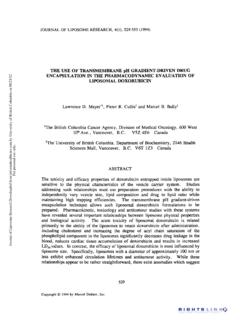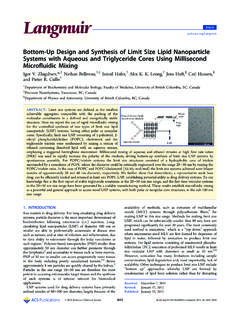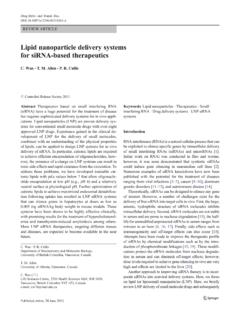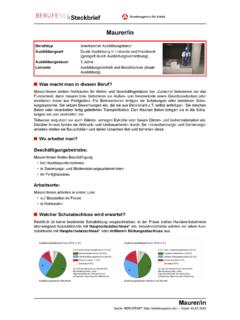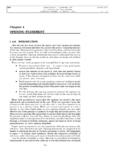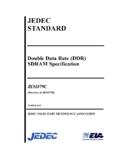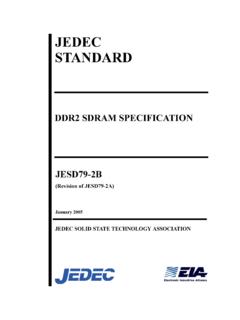Transcription of Anomalous solubility behavior of the antibiotic cipro ...
1 Anomalous solubility behavior of the antibiotic cipro oxacinencapsulated in liposomes : a1H-NMR studyNorbert Maurera;*, Kim F. Wonga, Michael J. Hopeb;c, Pieter R. Cullisa;caDepartment of Biochemistry and Molecular Biology, The University of British Columbia, 2146 Health Sciences Mall,Vancouver, V6T 1Z3, CanadabDepartment of Medicine, The University of British Columbia, F254 Koerner Pavilion, 2211 Wesbrook Mall,Vancouver, V6T 2B5, CanadacInex Pharmaceuticals Corporation, 100-8900 Glenlyon Parkway, Glenlyon Business Park, Burnaby, V5J 5J8, CanadaReceived 2 March 1998 ; accepted 11 May 1998 AbstractMany drugs are weak bases and can be accumulated into liposomes in response to a pH gradient to achieve high internaldrug concentrations. This study is aimed at gaining an understanding of the relationship between the retention of thefluoroquinolone antibiotic ciprofloxacin in liposomes and the intraliposomal form and location of this was used to probe the interactions experienced by ciprofloxacin following uptake into large unilamellarliposomes (LUV).
2 It is shown that ciprofloxacin is located in the aqueous interior of the liposomes and is self-associated inthe form of small stacks. It does not precipitate out of solution even though the intraliposomal ciprofloxacin concentrationcan exceed its solubility in aqueous solutions by almost two orders of magnitude. The results also indicate that littleentrapped ciprofloxacin partitions into the inner monolayer of the LUV. As a result of the lack of precipitation and rapidexchange properties, ciprofloxacin can respond quickly to changes in electrochemical equilibria such as depletion of the pHgradient. This provides a rationale for the rapid leakage of this drug in response to serum destabilization or depletion of thepH / 98 / $ ^ see front matter fl 1998 Elsevier Science All rights :Nuclear magnetic resonance ; Drug^membrane interaction ; Fluoroquinolone ; Transmembrane pH gradient ; Drug loading ;Solubility1.
3 IntroductionLiposomes are widely used as carriers for anti-cancer, antibiotic and antifungal drugs [1,2]. Encap-sulation of drugs in liposomes can reduce their acutetoxicity and may result in increased e cacy due tothe ability of small, long-circulating liposomes topreferentially accumulate at the site of disease. In-creased potency of antibiotics can occur as a conse-quence of the natural clearance of liposomes fromthe circulation by phagocytic cells, which are fre-0005-2736 / 98 / $ ^ see front matter fl 1998 Elsevier Science All rights : oxacin,asyntheticquinolonederivativewith activityagainstabroadspectrumofGram-pos- itiveandGram-negativebacteria,isoneofthe mostwidelyusedantibioticsforthetreatment ofrespira-tory,urinaryandentericinfectio ns[4,5].Itsbacterialactionresultsfromthe inhibitionoftheenzymeDNAgyrasewhichisnee dedforthesynthesisofbacterialDNA[6,7].
4 However,theuseofliposomalcarriersforcipr o oxacinisoneofalargenumberofdrugswithweak basecharacterwhichcanbeactivelyac-cumula tedinliposomesinresponsetoapHgradient[8^ 10].However,whilesomedrugssuchastheanti- cancerdrug,doxorubicin,areonlyslowlyrele asedfromtheliposomalcarrierinvitroorinvi vo,otherdrugsincludingcipro , oxacinloadedintoliposomesinresponsetotra nsmembranepHgradientshasbeensuggestedtob eprecipitatedoutintheliposomeinterior[11 ].Rea-sonsproposedforitsrapidreleaseinvi troandinvivowerelargersolubilityproductt hanotherdrugswhichareprecipitated,otherk indofdrugassocia-tionwithinthevesicles, oxacinafteraccumulationintolargeunila-me llarvesiclesdrivenbyatransmembraneproton gradient(vpH), ,theinteractionofcipro oxacinislocatedintheaqueousinteriorofthe liposomesintheformofstacksconsistingofas mallnumberofcipro ;however,thiscanbeexplainedbyprecipitati onorpartitioningintotheliposomemem-brane [9,12].
5 Thehighsolubilityofentrappedcipro- (DPPC)andpal-mitoyl-oleoylPC(POPC)werepu rchasedfromAvantiPolarLipids(Alabaster,A L),andweres99% (chol)andammoniumsul-fate(AS)wereobtaine dfromSigma( ,MO),anddeuteriumoxide(D2O)andsodium2,2- di-methyl-2-silapentane-5-sulfonate(DSS) fromCam-bridgeIsotopeLaboratories(Andove r,MA).[14C]Cholesterylhexadecylether(CHE )wascustomsynthesizedbyDuPontNewEnglandN uclear(Bos-ton,MA),[3H]CHE,[3H]methylami ne,[14C]sucroseand[3H] (Hornby,ON,Canada). cipro axacinhy-drochlorideaswellas[14C] cipro oxacinwereagiftfromINEXP harmaceuticals(Vancouver, ,Can-ada). (55:45mol/mol) (1998)9^2010vesicles(MLVs)wereformedbyhy dratingthelipidwitha300mMammoniumsulfate solutionfollowedby vefreeze^thawcycles[13]. lterswithporesizesof80, (NicompParticleSizingSystems,SantaBarbar a,CA).Averagehydro-dynamicdiametersweref oundtobe115 20nmand190 30nmfortheDPPC/cholLUVsextrudedthrough10 0and200nm lters,respectively,and75 20nmand155 30nmforPOPCLUVsex-trudedthrough80and200n m [14].
6 (NaCl)onG-50 Sephadexspincol-umns[15]. [14C]methylamineandwasperformedaspreviou slydescribed[16]. oxacinintoLUVsCipro oxacinwasaddedtotheseliposomesandthesamp leswereincubatedfor15minat60 oxacinconcentrationsdeterminedbyscintill ationcountingusing[14C] cipro oxacinorUV-absorptionat274nmafteraBligh^ Dyerextrac-tioninto200mMNaOHasaqueouspha se[17].Lipidconcentrationsweredetermined eitherbyscin-tillationcountingusingthera diolabeledlipid[3H]CHEorbytheFiske^ cienciesformolardrug-to-lipid(d/l;mol/mo l) :1withnormalmouseserumandincubationat37 (55:45mol%)werehydratedin1mlofa300mMammo -niumsulfate, [14C]sucroseor[3H]glucose,re-spectively, freeze^ , (1998)9^2011tatebu eratpH5wereaddedto10mMcipro , cante Candtheconcentrationofcipro oxacindeterminedaftercentrifugationfor15 minat3000 UginthesupernatantbyUVabsorptionat274nm, ( )wereincubatedinthepresenceofincreasingc oncentra-tionsofcipro oxacin( ^10mM)at25 Cfor2hin20mMsodiumacetate/100mMNaCl(pH5) andpelletedbyultracentrifugationfor90min ataRCFmaxof436000Ug(100000rpm).
7 (93%) ,however, , uorescenceorUVspectroscopy, ,pH-meterreadingsarereportedratherthanpD values( [18]).The1H-NMRexperimentswereperformedo naBrukerMSL200FT-NMRspectrometeroperatin gat200 MHz(47T).Ifnototherwisementioned,thetemp eraturewasmaintainedat20 , (60 pulse)andtheinterpulsedelay3s( ). ,2-dimethyl-2-silapentane-5-sulfonate(DS S).Thespin-latticerelaxationtimes,T1,wer emeasuredbytheinversion-recoverymethod(1 80 ^d^90 pulsese-quence). oxacinandrelated uoroquinolones[19^21]. uorineinposition6, uorineatomatthe7-position,apiper-azinemo ietyatthe6-position, [22]. uorineatomatthe7-position,apiper-azinemo ietyatthe6-position, ,pKa;COOH= ;N40= (1998)9^ oxacinbetweenthemembraneandtheaqueouspha secanleadtosigni cantbroadeningoftheNMRsignals, [23,24].Theywerespeci callyappliedtostudythedi usionofwateracrosslipidbilayers,wherethe internalandexternalwaterweredistin-guish edbythepresenceofparamagneticionsinei-th ercompartment[25,26].
8 Thespin^spinrelaxationisresponsibleforth elinebroadening(vX=1/ZT2).Theobservedrel axationtimes,T2,dependonthepopu-lationfr actionsandexchangerate(1/dex)accordingto :T2 paqpmem T2;mem dex 1 whereT2;memistherelaxationtimeinthemembr aneintheabsenceofexchange,paqandpmemthep opu-lationfractionsofcipro oxacinintheaqueousphaseandthemembrane,an ddextheexchangetimeofcipro oxacinbetweenaqueousphaseandmembrane(ort heaverageresidencetimeofcipro oxacininthemembrane)[26].Althoughinsu ,alowerlimitcanbeestimatedfromatheoretic allowerboundforT2; ;memisat-tainedifthemoleculesenterthemem braneinacer-tainstate(orientation,confor mationalstate) (t)Vexp 3M22t2=2 Vexp 3t2=2T22;eff)withane ectiveT2;effw(1/M2)1=2[27].Abragam[28]gi vesthefollowingformulaforthesecondmoment M2jofaspinjcoupledbydipo-larinteractions toNspinsk(k=1,2,TN)havingthesamegyromagn eticratio,Q,asspinj:M2j 3=5Q4X2I I 1 P1=r6jk,whereIisthespinofeachnucleusandr jkthedistancefromspinjtospink[28].
9 T2;effcanbetakenasalowerlimitforT2inthem embrane:T2;memvT2;eff=(1/M2)1=2= (A )3(forr=4A ,T2; ,T2; ). (paq/pmem)T2;mem,thusyieldinganupperlimi ttothepredictedlinebroadening(vX=1/ZT2) andvX9549 Hzforr=2A , oxacinarewithin3A (foramodeledthree-dimensionalstructureof cipro ). oxacinisreleasedrapidlyfromLUVsinthepres enceofserumIthasbeendemonstratedthatcipr o oxacincanbeaccumulatedtohighconcentratio nsinsideliposomesinresponsetoatransmembr anepHgradient[11,29,30]. oxacinisrapidlyaccumulatedintoDPPC/cholL UVsat60 C, ,itisalsorapidlyreleasedfromtheLUVsoninc ubationin50%mouseserumat37 CordepletionofthepHgradientat25 Cin150mMammoniumacetate( ,rightside).Serumpro-teinspermeabilizeth emembrane, oxacindoesnotprecipitateintheliposomeint eriorTheconcentrationofcipro oxacininsidelipo-somescanbeveryhigh(upto 300mM).Thesolu-bilityofcipro ; (1998)9^2013ever,theammoniumconcentratio nisreducedbytheamountofcipro ox-acinasafunctionofammoniumsulfateconce ntra-tionat25 CandpH5, (5^20mMDPPC/chol)hadnosigni cante ectonthesolubilityofcipro (20^30%).
10 Theintraliposomalcon-centrationofcipro ,90^95%uptakeandaninternalvolumeof2Wl/Wm ollipidfor200nmDPPC/cholLUVsisbetween225 ^ oxacinloadedinto200 ( ,c).Twofeaturesofthespectrumofencapsulat edcipro ,allresonancesareclearlyvisiblethoughsig ni ,largeup eldshiftsofthear-omaticprotonresonances( H2,H5,H8)ascomparedtofreecipro ciencywas90%with10%externalcipro oxacininto200nmDPPC/ Cfor30min(opencircles). cipro oxacinfromtheLUVsin50%mouseserum(fullcir cles)andin150mMammoniumacetate(depletion ofthepHgradient,fullsquares). oxacininto200nmDPPC/ (a)1H-NMRspectrumofcipro oxacinloadedinto200nmDPPC/cholLUVs(d/l= ).Approximately90% eldregion.(b)1H-NMRspectrumofcipro oxacinin150mMNaClsolu-tionintheabsenceof liposomesatthesameconcentrationaswasused fortheuptakeabove(ccipro=9mM).Theassignm entsofthearomaticresonancesaregiveninthe (c)1H-NMRspectrumof200nmDPPC/cholLUVs(c= 40mM).
